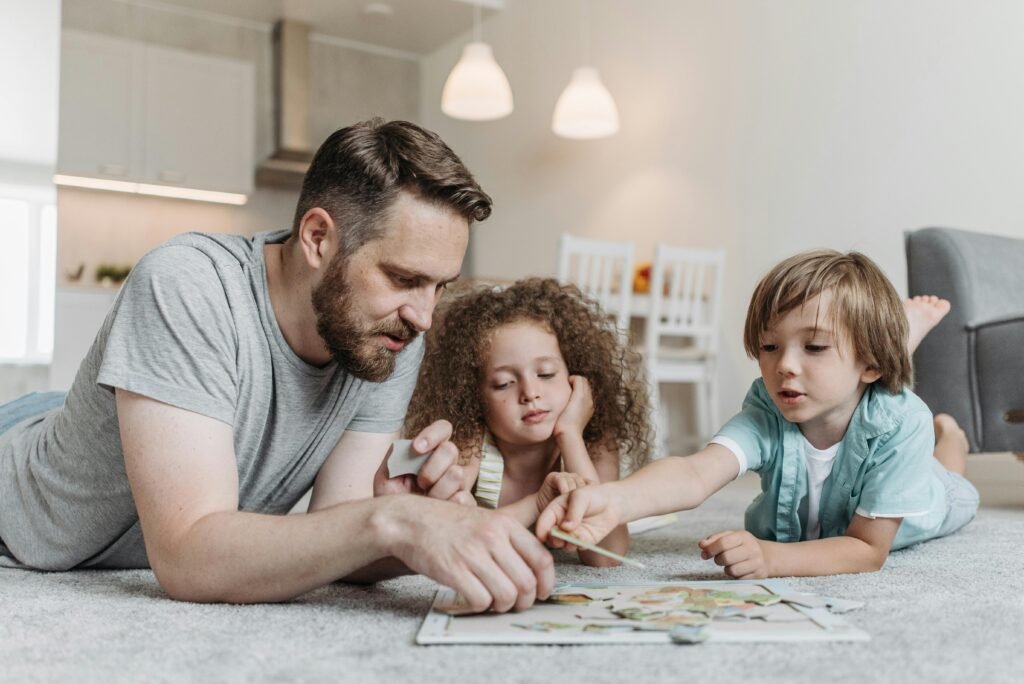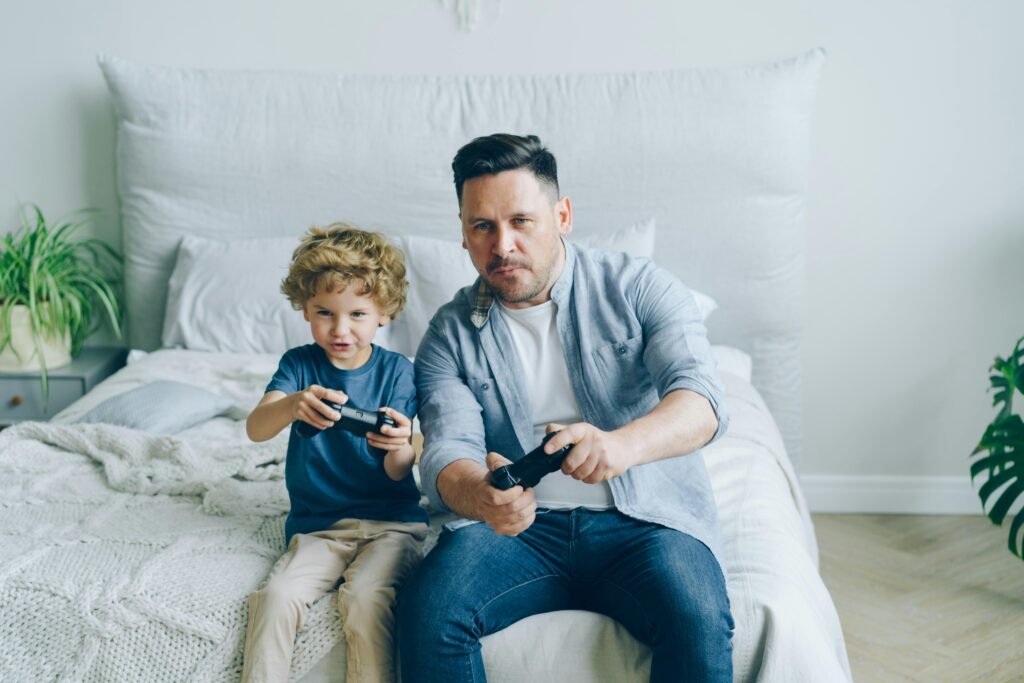Parenting in the digital age is tough. Screens are everywhere—TVs, tablets, phones, and laptops. And kids? They’re using them more than ever. Whether it’s for school, games, social media, or just watching cartoons, children are spending huge chunks of their day staring at screens.
86% of parents use some form of parental controls on their children’s devices
This number shows us something very important: most parents are trying. They’re not ignoring the screen problem. They’re taking action. And the first step many take is turning on parental controls.
Parental controls are built into most devices these days. Whether it’s a phone, a tablet, or even a smart TV, there are settings that help limit what kids can see and do. These tools are a great first step, but they work best when parents also talk with their kids about why they’re there.
Here’s what works. Set up controls together with your child. When your child is involved, they feel respected. They understand that the goal isn’t to punish them—it’s to keep them safe. This turns rules into teamwork, and that changes everything.
Also, make sure your controls match your child’s age. A five-year-old might need strict filters, while a ten-year-old may just need help staying away from certain apps. Adjust as they grow.
Another smart tip: review controls monthly. Kids change fast. What worked last month might not fit today. Check app settings, screen time reports, and content filters. It only takes ten minutes, but it keeps things current and helpful.
The key here isn’t about spying or blocking everything. It’s about setting boundaries that help kids build smart habits. When kids know the limits, they feel more secure—and that makes them more likely to use tech in healthy ways.
So if you’re one of the 86%, you’re not alone. Keep going. And if you’re not there yet, it’s never too late to start. A few changes today can make a big difference tomorrow.
73% of teens say their screen time is often monitored by parents
Teens know when you’re watching. And guess what? Most of them don’t actually mind. They understand it’s part of being a family.
Monitoring doesn’t mean controlling every tap or swipe. It means staying aware. Teens say they notice when parents check in. And even though they may roll their eyes or groan, they often feel safer knowing someone is looking out for them.
So how can you monitor in a way that works? The answer is simple: keep it open, honest, and fair.
Start by setting up screen time reports. Most phones and tablets can show you exactly how much time your child spends on each app. Instead of hiding this info, share it. Sit down once a week and look at it together. Ask questions like, “How did you feel after using this app?” or “Do you think we should make any changes?”
This kind of talk builds trust. And trust is what keeps monitoring from feeling like spying.
If you see something that worries you—like late-night use or time on risky sites—bring it up gently. Say, “I noticed you’ve been up really late on your phone. Want to talk about it?” Stay calm and curious, not angry or accusing.
When teens feel respected, they’re more likely to open up. They’re also more likely to make smarter choices on their own. That’s the real goal.
Monitoring works best when it’s part of a bigger plan—a plan where screens are a tool, not a problem. Keep talking. Keep checking in. And remind your teen that you’re on their side.
60% of parents say setting screen time limits helps improve their child’s sleep
Sleep is everything. When kids don’t sleep well, everything gets harder—school, focus, mood, even friendships. That’s why this stat is so important. When parents set time limits, kids sleep better.
Screens mess with sleep in two big ways. First, the light from screens tricks the brain into staying awake. Second, exciting content—like games or videos—makes it hard to calm down. That’s why experts recommend turning off screens at least one hour before bedtime.
But how do you make that happen?
One smart move is to create a wind-down routine. Start with something simple like reading a book or listening to music. Turn off all screens—TVs too—at the same time every night. Keep phones and tablets out of bedrooms. Charge them in the kitchen or living room instead.
Also, let your child help design their bedtime routine. Ask them what calms them down. Maybe they like drawing or puzzles. The goal is to replace screen time with something peaceful.
If they push back, stay kind but firm. Say, “I know it’s hard, but your brain needs rest to grow strong.” Make it part of the family routine. No screens before bed—for anyone. When kids see grown-ups following the rule too, they’re more likely to stick with it.
You might be surprised how quickly things improve. In just a few days, many parents report their kids falling asleep faster and waking up happier. That’s the power of setting limits that protect what matters most—rest, health, and peace of mind.
45% of children aged 8–12 exceed recommended screen time limits daily
That’s nearly half of all kids in this age group. It’s not because they’re bad or lazy. It’s because screens are designed to pull us in—and keep us there.
Apps, games, and videos are made to be exciting. They reward clicks, likes, and wins. For an 8-year-old, it’s very hard to stop on their own. That’s where time limits come in.
First, let’s talk about what the experts say. Most health organizations recommend no more than 1 to 2 hours of recreational screen time per day for kids 6 to 12. That’s time for fun, not schoolwork. But many kids go far beyond that.
So what can you do?
Start with a simple timer. Set it when screen time begins and give your child a gentle heads-up when time is almost up. When the timer goes off, screen time is done.
Next, create a daily schedule. Write down what happens before screens—things like homework, chores, or outdoor play. Make it visual. Use stickers, drawings, or magnets. Kids love checking things off, and it helps them stay on track.
Also, give choices. Ask, “Would you like 30 minutes of screen time now or after dinner?” This gives kids control within limits, and that helps reduce battles.
If your child struggles to stop, try screen-free days. Pick one day a week to unplug as a family. Go for a walk, play a board game, or cook together. The first time might be hard, but over time it gets easier—and more fun.
Remember, the goal isn’t just less screen time. It’s better screen time. Quality matters. Choose apps and shows that teach, build skills, or spark imagination. And always keep checking in to see how your child is feeling.
71% of parents feel overwhelmed trying to manage screen time
You’re not alone if you’ve ever felt lost trying to set screen rules. Over 7 out of 10 parents feel the same. It’s not easy to balance freedom and limits, especially when screens are part of everything—school, fun, friendships, and even chores.
The good news is, feeling overwhelmed is not a sign of failure. It just means the job is big. And you don’t have to do it all at once.
Start small. Pick one area to focus on this week. Maybe it’s bedtime screens. Maybe it’s reducing YouTube time. Whatever it is, focus just on that. Once it feels normal, move on to the next thing.
Also, remember that screen time rules don’t have to be perfect. They just have to be clear and consistent. Kids are happier when they know what to expect. Write down your screen rules. Put them on the fridge or somewhere easy to see.
Another trick: share the load. Talk to your partner, older kids, or even grandparents about helping you keep the rules in place. When everyone is on the same page, it gets a lot easier.
There are also many tools that can help. Apps like Google Family Link or Apple Screen Time let you set limits, block content, and see how your child uses their device. These tools don’t replace parenting—but they sure make it easier.
And finally, take breaks yourself. Unplug sometimes. Go for a walk. Have tech-free meals. When your child sees you balancing screen time, they’ll learn to do it too.
You don’t have to figure it all out today. Just take one small step forward. That’s enough.
38% of parents say arguments about screen limits happen weekly
Screen time is one of the biggest sources of family fights today. And it’s no wonder. Kids want more time. Parents want less. And emotions run high on both sides.
Nearly 4 out of 10 families are arguing every single week over this. That’s a lot of stress. But it doesn’t have to be that way.
The secret to fewer arguments? Clarity and calm conversations.
Start by making screen rules ahead of time—not in the moment. For example, say: “You can have one hour of screen time after school, once your homework is done.” Write it down. Stick to it. Don’t change the rule just because your child begs. Consistency builds trust.
If your child argues, don’t argue back. Stay calm. Say, “I understand you’re upset. The rule is still the same.” Repeat it gently. Kids test rules to see if they’ll break. When they see you staying firm and kind, they start to accept it.
Also, involve them in rule-making. Ask, “What do you think is fair?” You don’t have to agree to everything, but listening helps. When kids feel heard, they’re less likely to fight back.
Create a “no-arguing” rule. Let your child know that if they argue, screen time ends early. This gives them a choice. They can be upset—but not disrespectful. Over time, this rule changes behavior.
And don’t forget to praise good behavior. Say, “Thanks for turning off your game without a fuss.” A little praise goes a long way.
Arguments are normal. But they can become fewer and softer when the rules are steady, the tone is calm, and everyone knows what to expect.
50% of parents report improved family relationships after enforcing time limits
Half of all parents see something amazing happen when they start setting screen rules—family bonds get stronger.
Why does this happen? Because when screens are limited, families have more time to talk, play, and simply be together. Real moments replace mindless scrolling. And those moments matter.

Dinner becomes a time to laugh, not just eat in silence. Evenings become a chance for board games, books, or silly dances in the living room. These small things build deep connection.
It all starts with one decision: to guard your family’s time.
Start by picking a few tech-free times each day. Mealtimes are a great place to begin. Make it a family rule—no phones at the table. Not for texts, not for videos. Just faces, food, and voices.
Next, try a weekly unplugged night. Choose one evening where screens go off. Light candles. Play cards. Take a walk. Bake cookies. The activity doesn’t matter—the connection does.
Also, invite your kids to help plan. Ask, “What would be fun to do tonight without screens?” When they help choose, they feel included. And they’re more likely to enjoy it.
You don’t have to ban screens forever. Just make room for moments without them. Over time, you’ll see your family laugh more, talk more, and grow closer.
Time is precious. Protect it. Your kids won’t remember the video they watched—but they’ll remember the way you made them feel.
58% of teens admit to trying to bypass parental control settings
Teens are smart. And when they want more screen time, many try to find ways around the rules. Over half of them admit they’ve done it—turned off timers, deleted apps, or used secret accounts.
This doesn’t mean they’re bad kids. It means they’re curious, growing, and testing limits. That’s part of being a teenager.
But it does mean that controls alone aren’t enough. You need connection, too.
First, talk openly. Say, “I know it might be tempting to find a way around the rules. But let’s talk about why the rules are there.” Be honest. Share your concerns. Not just about danger—but about balance, health, and focus.
Next, set up smart controls. Use passwords only you know. Make sure your child can’t turn off settings without your okay. And check in often. If something looks off—like an app disappearing—ask about it.
Also, watch for sneaky signs. If your teen is always “running out of battery” or “lost their charger,” it might be an excuse. Stay kind but aware.
More than anything, build trust. If your teen sees you as a helper—not a jailer—they’re less likely to hide things. Let them know you’re here to support them, not control them.
And finally, don’t take it personally. If your teen tries to sneak around, stay calm. Use it as a teaching moment. Ask, “What made you feel like you needed to do that?” Then listen. Really listen.
Teens need guidance, not just rules. When they feel safe talking to you, they learn to make better choices—even when no one’s watching.
65% of kids show better school performance when digital time is limited
This is a powerful stat. When screen time is limited, nearly two-thirds of kids do better in school. That includes better focus, more homework completed, and even higher grades. It’s not magic—it’s about having more time and mental space to learn.
Too much screen time, especially for entertainment, can crowd out the time kids need for reading, writing, and thinking. The brain gets used to fast-paced videos and games, and slower tasks like math or reading start to feel boring. But once screen time is dialed back, kids start engaging more with their schoolwork.
So how can you help this happen at home?
Start with a simple after-school routine. Make it screen-free until homework is done. This helps kids build strong study habits. It also tells their brain, “First we work, then we play.”
Keep screens out of homework time unless they’re needed. Even “just five minutes” of checking messages can break a child’s focus and turn homework into a battle.
If possible, create a study zone in the house—quiet, well-lit, and without devices nearby. Let your child decorate it. When the space feels personal, kids are more likely to use it.
Also, reward good habits. Say things like, “I noticed you stayed focused for twenty minutes today. That’s awesome.” Praise builds motivation more than punishment ever will.
Another trick? Keep weekends balanced. Even if school isn’t happening, too much weekend screen time can affect sleep and focus on Monday. Try planning fun, non-screen activities for Saturday mornings or Sunday evenings to help ease the transition back to school.
Remember, you’re not taking away screens—you’re giving your child space to succeed. That space can help them grow into learners who focus better, think deeper, and feel proud of their work.
92% of parents believe time limits should change with a child’s age
Almost every parent agrees—one rule doesn’t fit all. A six-year-old and a sixteen-year-old don’t need the same screen time. As kids grow, their needs, challenges, and responsibilities change. And the rules should change too.
This doesn’t mean there’s no structure. It just means you adjust the boundaries as your child becomes more independent. Think of it like training wheels. You take them off slowly, not all at once.
For young children, stricter limits make sense. At that stage, they’re still learning how to manage time, follow rules, and make choices. You might limit screens to one hour a day, and only certain apps or shows.
As kids grow, give more freedom—but with clear expectations. For example, a 12-year-old might have two hours of screen time, but still no screens after 8 p.m. Or a teen might get three hours, as long as grades stay up and chores are done.
Talk with your child about these changes. Say, “You’re getting older, and I want to give you more freedom. But let’s agree on what that looks like.” This builds trust. It also teaches kids that freedom comes with responsibility.
And don’t be afraid to roll things back if needed. If screen time gets out of control or school slips, adjust the limits again. Let your child know that rules grow with them—but can tighten if needed.
This way, your child learns not just how to use screens—but how to manage themselves. That’s a life skill they’ll carry forever.
48% of children experience improved focus with restricted screen time
Almost half of all kids focus better when they spend less time on screens. This isn’t just about getting homework done—it’s about being able to sit still, listen, think, and solve problems. Those are the skills that help in school, at home, and later in life.
Screens can scatter focus. Videos jump fast from one thing to the next. Games demand quick decisions. Social media keeps attention flipping back and forth. All this trains the brain to crave constant stimulation.
But when screen time is limited, kids start to slow down and settle in. They can read longer, build more complex Lego sets, or focus better in class.
How can you support better focus at home?
One way is to have screen-free blocks of time. Even 30 minutes a day with no screens—just quiet play, drawing, puzzles, or reading—can help train focus muscles.
Another idea is to use timers for screen use. Instead of unlimited play, say, “You can play this game for 20 minutes, then take a 10-minute break.” Breaks help reset the brain.
Also, help your child plan their time. Ask, “What do you want to do first—homework or screen time?” Let them choose the order, but not the rules. This teaches them how to manage time wisely.
If your child gets frustrated when the screen turns off, stay calm. Say, “It’s hard to stop, I know. Let’s take a deep breath together.” Over time, their ability to switch tasks will improve.
And celebrate progress. If your child reads quietly for 15 minutes without checking a device, cheer them on. Focus grows slowly, like a plant. But with the right care, it grows strong.
82% of parents say using app blockers reduces distractions during study time
Most parents who try app blockers say they really help. That’s because distractions are everywhere—messages, games, videos, even harmless apps like calendars or photos.
During study time, these distractions add up. One quick peek becomes ten wasted minutes. The brain takes time to get back on track after each distraction. That’s why even small interruptions matter.
App blockers are simple tools that temporarily shut off certain apps or websites. Some popular ones include Freedom, Cold Turkey, and Focus Mode (on Android and iOS). You can choose which apps to block and for how long.

Here’s how to make it work.
Before study time, sit down with your child and set the blocker together. Let them choose the apps to pause—this gives them a sense of control. Explain that the goal is not punishment—it’s about helping the brain work better.
Start with short sessions. Try 25 minutes of focus with a 5-minute break. This is called the Pomodoro method, and it works for kids too. During breaks, they can check messages or play a short game. Then it’s back to work.
Also, use the blocker yourself. Show your child that grown-ups need help staying focused too. This sets a powerful example.
And check in after study time. Ask, “Did it help to block those apps?” or “Should we change anything tomorrow?” Keep it a team effort, not a top-down rule.
App blockers are tools—not magic fixes. But when combined with routine, praise, and clear goals, they can help your child focus better, study smarter, and feel more confident.
67% of parents use device downtime settings daily
Two-thirds of parents are now using “downtime” settings on devices—and they’re doing it every day. That’s a big step in building healthier screen habits at home.
Downtime is a built-in feature on many phones and tablets. It lets you set hours when the device can’t be used—except for emergency calls or a few chosen apps. This makes it super easy to create screen-free times like bedtime, meals, or study hours without needing to nag.
And the best part? It’s automatic. Once it’s set, you don’t have to keep reminding your child to put the screen down. The device just locks it for them.
To get started, pick a few key hours each day that should be screen-free. The most popular times? Right before bed, during dinner, and in the morning before school. For example, you might set downtime from 8:00 p.m. to 7:00 a.m.
Set it up together with your child. Let them help pick which apps stay on—like the clock or music player—and which get blocked. Kids are more likely to follow rules they helped create.
If your child resists, stay calm. Say something like, “Our brains need rest just like our bodies. Screens at night make it hard to sleep. Let’s help your brain relax.”
You can also use downtime to create family rituals. Maybe after 8:00 p.m., everyone reads together or does a quiet activity. When screens go off for everyone—not just the kids—it sends a strong message: We do this as a family.
Downtime helps kids learn when to disconnect, not just how. And over time, it teaches them one of the most important life skills—self-regulation.
33% of kids show reduced anxiety with less screen time
One-third of children feel less anxious when they spend less time on screens. That’s a big deal.
Today’s digital world moves fast. Kids scroll through hundreds of images, videos, and comments in minutes. Social media can make them feel left out. Games can make them frustrated. Even YouTube can overwhelm their senses. All this can build up as stress.
But when screen time goes down, kids often feel calmer. They sleep better. They play more. They talk more. They feel less pressure to be “on” all the time. And that gives their brains a chance to reset.
So how can you lower screen time without a fight?
Start by watching for signs of anxiety. Is your child more irritable? Avoiding friends? Biting nails or having trouble sleeping? These can all be clues that it’s time to take a step back from screens.
Then, gently talk about it. Say, “I’ve noticed you seem a little more worried lately. Sometimes screens can make that worse. Let’s take some time each day to unplug and just relax.”
Offer calming alternatives. Try a short walk, coloring, journaling, or just sitting together quietly. Let your child pick what feels good. It doesn’t have to be perfect—just screen-free.
Set small goals. You don’t have to remove screens completely. Just reduce the time little by little. Even 15 fewer minutes a day can help.
And finally, be present. Sometimes the best way to help anxiety is to simply sit with your child, listen, and say, “I’m here.”
Reducing screen time won’t fix everything, but it can open the door to peace, calm, and better mental health.
90% of parents believe time limits help teach self-discipline
Most parents aren’t just setting screen rules to control behavior. They’re doing it because they know it teaches something bigger—self-discipline.
Self-discipline is about learning to stop, wait, focus, and choose well. These are skills that help kids not just now, but for life. And screen time is a perfect way to practice them.
When you set time limits, you’re giving your child a chance to learn how to manage themselves. To stop playing when the time is up. To choose a book instead of a game. To think, “I’ve had enough for today.”
But here’s the secret: time limits only teach self-discipline when they’re consistent.
If the limit changes every day—or is removed when your child complains—it sends a different message: that rules can be ignored.
So be steady. Pick a daily limit that works for your family. Maybe it’s one hour after school. Or 30 minutes before dinner. Keep it simple, clear, and predictable.
Let your child use a timer or screen tracker. This puts the control in their hands. They start to see time as a real thing, not just something adults nag about.
And celebrate when they stick to it. Say, “You stopped on time. That shows self-control. I’m proud of you.” Praise helps build habits.
As they get older, give them more say. Let them help decide how to use their screen time. This builds planning skills and responsibility.
Time limits are not about taking something away. They’re about giving your child the power to manage themselves—and that’s one of the best gifts you can give.
40% of parents rely on built-in device controls rather than third-party apps
Almost half of parents stick with the built-in tools on phones and tablets to manage screen time—and that’s great news. It means setting boundaries can be simple, fast, and effective.
You don’t need fancy apps or special devices. Most phones, tablets, and computers already come with tools to set limits, block content, and track usage.
On iPhones and iPads, it’s called Screen Time. On Android devices, it’s called Digital Wellbeing. These tools let you see how much time your child spends on each app, set daily limits, and even schedule downtime hours when the device locks itself.

Here’s how to make the most of these built-in settings.
First, explore together. Sit down with your child and open the settings. Show them how it works. Let them see how much time they’re using. Sometimes just seeing the numbers is a wake-up call.
Next, set clear limits. Choose a few apps that need boundaries—like YouTube or games. You don’t have to limit everything. Just start where the time is getting out of hand.
Turn on app approvals if your child is younger. This means they can’t download anything new without your okay.
Use downtime mode for sleep hours, and communication limits so they can’t message friends late into the night. Customize it to fit your family’s needs.
The beauty of built-in tools is that they’re easy to find, easy to use, and don’t cost a thing. They give you a simple way to take control without adding more stress.
And remember—it’s not just about controlling the device. It’s about guiding your child. These tools give you a way to lead with calm, structure, and care.
55% of families experience better mealtime behavior with screen rules
More than half of families notice something special when they set screen limits at mealtimes—everyone behaves better. That means more talking, less arguing, fewer meltdowns, and yes, even better manners.
Screens at the table do more than distract. They interrupt eye contact. They keep kids from noticing how they feel. They also stop families from having real conversations, which are so important for connection and emotional growth.
But when screens go away during meals, something shifts. Kids start to engage. They look up. They talk about their day. And slowly, meals become something everyone enjoys.
To get started, create a no-screens-at-the-table rule. Not just for the kids—for everyone. That includes parents. No phones. No tablets. No TVs in the background.
If your child resists, make it fun. Light a candle. Play soft music. Let them help set the table. When meals feel special, they’re easier to enjoy—even without screens.
Start with one meal a day. Dinner is a great place to begin, but even breakfast or weekend lunch works. The key is to build consistency.
Use this time to ask simple, open questions. “What was something funny that happened today?” or “What’s one thing you’re proud of?” This helps kids open up—and you’ll be surprised at what they share.
Also, don’t worry if your child is quiet at first. The goal is not to force conversation, but to make space for it. With time, even the shyest kids begin to open up.
Family meals are more than just food. They’re moments to connect, listen, and feel safe. And putting screens aside—even for 20 minutes—can make those moments more powerful than you imagine.
80% of parents feel time limits help protect kids from online dangers
Four out of five parents believe screen time rules do more than control behavior—they protect their children. And they’re absolutely right.
The online world can be wonderful. It can also be risky. From inappropriate content and online predators to cyberbullying and unhealthy comparisons, there’s a lot out there that kids simply aren’t ready to handle on their own.
Time limits act like a digital fence. They don’t just cut down on exposure—they give parents space to talk, guide, and check in.
Start by being honest with your child. Say something like, “There are things online that aren’t safe or kind. My job is to help you stay away from those things until you’re ready.”
Use screen time tools to set limits on what your child can use, when, and for how long. You can also block certain websites or types of content. Many platforms, like YouTube Kids, allow you to filter content by age.
But don’t rely on settings alone. Regular check-ins are just as important. Ask, “Did anything weird come up while you were online today?” or “Did anything make you uncomfortable?” Keep your tone curious, not judgmental.
Also, teach your child what to do if they see something wrong. Let them know they can always come to you—without getting in trouble.
The goal is not to make them afraid. It’s to make them prepared. And the earlier you start these conversations, the safer your child will be.
Time limits aren’t just about health or homework. They’re a key part of digital safety. When you manage screen time with love and awareness, you’re giving your child tools to navigate the internet with confidence and care.
59% of kids sleep better when screens are off one hour before bed
This stat shows just how powerful one small change can be. Turning off screens an hour before bed helps nearly 6 in 10 kids sleep better. That means they fall asleep faster, stay asleep longer, and wake up feeling more rested.
Why does this work so well? It’s all about how the brain works.
Screens—especially phones and tablets—give off blue light. This light tells the brain to stay awake. It also stops the body from making melatonin, the chemical that helps us fall asleep. Add in the excitement from games or videos, and your child’s brain gets stuck in “go” mode when it should be winding down.
Turning off screens early gives the brain a chance to slow down and relax. That’s when real rest happens.
Here’s how to build this habit.
Set a “screens off” time that’s one hour before your child’s bedtime. Make it part of the daily routine. For example, if bedtime is 9:00 p.m., screens go off at 8:00 p.m.
Help your child find quiet, calming things to do instead. Reading, coloring, puzzles, gentle music, or even just chatting with you all help the brain slow down.
Also, move devices out of the bedroom. Charge them in the kitchen or hallway overnight. If your child uses a device as an alarm, replace it with a basic alarm clock.
You might get some resistance at first. But stick with it. After a few nights, your child will begin to fall asleep more easily—and that alone can improve their whole day.

Better sleep leads to better moods, better focus, and better health. All from one simple change.
74% of children benefit from a tech-free bedtime routine
This stat adds to the last one—routine matters. Not just turning off screens, but replacing them with calming habits that help the body and brain know it’s time to rest.
A tech-free bedtime routine doesn’t have to be long or fancy. It just has to be peaceful, predictable, and screen-free.
Start with three or four simple steps. For example: bath, pajamas, story, lights out. Or maybe it’s brushing teeth, drawing quietly, reading a book, then cuddling in bed.
Keep it the same every night. This helps your child’s brain build sleep signals. Over time, just starting the routine can make them feel sleepy.
If your child struggles to fall asleep, try adding calming rituals like deep breathing, stretching, or a warm drink (like milk or chamomile tea). Some kids also enjoy calming music or white noise in the background.
You can also give your child a special job during the routine—like choosing the bedtime book or picking their pajamas. These small choices help them feel more in control.
The goal is to move slowly and gently from “day mode” to “night mode.” This helps your child settle their thoughts, relax their body, and drift off naturally.
And the best part? These routines aren’t just good for kids—they’re calming for parents too. Doing the same peaceful steps each night brings a sense of rhythm and connection to the whole family.
No tech. No stress. Just calm, cozy endings to the day.
42% of teens say they appreciate clear screen time boundaries
It may come as a surprise, but nearly half of all teens actually like having screen rules in place. Even though they may roll their eyes or push back sometimes, deep down, they feel more secure when boundaries are clear.
Why? Because clear limits remove the guesswork. Teens already face a lot of pressure—from school, social media, and friendships. When parents set firm, kind rules around screen use, it gives teens one less thing to stress about. They don’t have to figure it out alone.
So how do you create boundaries that teens appreciate?
Start with honesty. Tell your teen, “I’m setting these limits because I care about your health and your focus—not because I don’t trust you.” This helps keep the tone respectful.
Involve them in the process. Ask questions like, “How much screen time do you think is reasonable on a school night?” or “What time do you think screens should be off at night?” Teens are more likely to follow limits they helped create.
Be consistent but flexible. Maybe your teen gets more screen time on weekends, or extra time for creative use (like drawing or coding apps). Show them that boundaries are about balance—not control.
And don’t forget follow-through. If your teen breaks the rule, follow up calmly. Say, “I noticed we went over our limit today. Let’s talk about how we can reset.” This keeps the focus on growth, not punishment.
Teens may not always say it, but they crave structure. Screen rules give them that. And over time, they’ll thank you for it—even if it’s not today.
29% of parents feel confident managing screen time without help
Only about 1 in 3 parents say they feel truly confident handling screen time on their own. That means most parents—71%—are unsure, worried, or overwhelmed.
This is completely normal. Managing screens isn’t just about setting a timer. It’s about understanding tech, keeping up with trends, handling moods, and staying consistent—every single day.
If you’re one of the 71%, take a deep breath. You don’t have to know everything. You just need a plan, a few tools, and a bit of support.
Start by picking one priority. Maybe it’s better sleep. Maybe it’s less time on TikTok. Choose one goal for the week and focus on that. Small wins build confidence fast.
Use built-in controls on devices to make limits easier. You don’t need to be a tech expert—most tools are simple and guide you step-by-step.
Lean on your community. Talk to other parents, teachers, or even older siblings about what’s working for them. Sharing ideas and stories can make you feel less alone—and more equipped.
You can also check out resources from trusted sites, apps like Family Link or Screen Time, or even local parenting classes. There’s no shame in learning as you go.
And most of all, give yourself grace. You don’t have to be perfect. If you mess up or change the rule mid-week, that’s okay. Just get back on track the next day.
Confidence grows with practice. Every time you set a limit, guide a conversation, or reset a boundary, you’re getting better at this. And your child is learning right alongside you.
61% of parents use time limits for gaming apps specifically
Games are fun—but they can also be addictive. That’s why more than 6 out of 10 parents are setting specific time limits just for gaming apps.
Games are built to keep kids playing. They offer rewards, levels, and streaks that make it hard to stop. And while many games are harmless fun, too much time spent gaming can crowd out sleep, schoolwork, and social time.
The key is not banning games—but balancing them.
Start by talking to your child about why time limits matter. Say, “I know you love playing, but our brains need breaks too.” Keep the tone respectful, not critical.
Use built-in settings to limit how long a game can be played each day. Many devices allow you to set specific limits for apps like Roblox, Fortnite, or Minecraft.
If your child plays on a console (like Xbox, PlayStation, or Nintendo Switch), explore their parental control options. You can usually set time windows and total daily playtime.

Also, create a gaming schedule. For example, 30 minutes after homework on weekdays, and up to 2 hours on weekends. Post the schedule where everyone can see it.
Keep an eye on your child’s mood after gaming. Are they cranky, overexcited, or zoned out? That’s a sign the session might’ve been too long.
When your child sticks to the rules, notice it. Say, “Nice job turning off the game on time.” That little praise helps build long-term habits.
Games can be part of a healthy life. But they should be one piece—not the whole picture. Time limits help keep that balance in place.
88% of families report better balance when screens are limited on weekends
Almost 9 in 10 families say their weekends feel more balanced when screen time is limited. That’s huge. It means less rushing, less arguing, and more time doing things that matter.
Weekends often become screen marathons for kids. No school, no schedule, and hours of free time? It’s easy for games and shows to take over. But families who plan ahead say the results are worth it.
Start by creating a weekend screen plan. This doesn’t mean cutting out all screens—but creating a rhythm. For example, no screens before lunch. Or screen time only after an outdoor activity.
Let your child help design the plan. Ask, “What’s something fun we can do Saturday morning without screens?” Build a short list of go-to activities—biking, drawing, baking, board games.
If you do allow screen time, try group screen time. Watch a movie together or play a family-friendly video game. This turns screens into bonding time instead of solo time.
Also, make space for boredom. When kids are bored, they often come up with the best ideas. Give them time without devices and watch their creativity grow.
And keep your own screen use in check. If you’re glued to your phone all weekend, they’ll follow your lead. Unplug with them, even just for an hour or two.
Weekends are short. But with a little planning, they can become something special—full of fun, connection, and real rest.
37% of children feel less moody with reduced screen exposure
Over one-third of kids say they feel less moody when they cut back on screen time. That means fewer meltdowns, less whining, and a more peaceful home.
Screens affect emotions in sneaky ways. Fast-moving games and videos can overstimulate kids. Social media can make them compare themselves to others. And long hours of screen time often leave kids tired, restless, or cranky.
When screen time goes down, the nervous system gets a break. The brain gets time to rest, and kids become more in tune with how they feel.
Start by observing your child’s mood after screen time. Are they calm and happy—or irritable and impatient? Use this as a starting point for change.
If mood swings are common, try replacing some screen time with calming activities. Drawing, puzzles, reading, building with blocks—these help children reset. And even better, they’re things kids can do on their own.
Introduce “quiet time” each day. No screens. Just 20–30 minutes of downtime. It might feel awkward at first, but over time, your child will learn to enjoy the stillness.
When your child does well during screen-free times, praise them. Say, “You’ve been so calm today—I think taking that break really helped.” Connect their mood to the screen changes so they can notice it too.
This isn’t about being anti-screen. It’s about helping your child learn what makes their body and brain feel good. And once they feel the difference, they’ll want to protect that peace too.
64% of parents co-create time rules with their children
Nearly two-thirds of parents don’t just make the rules—they make them with their kids. And this simple shift changes everything.
When rules are made together, kids feel respected. They understand the “why” behind the limit. And they’re much more likely to follow through, because it’s something they helped build.
Start by having a screen time meeting. Keep it short—15 minutes is plenty. Say, “Let’s come up with some screen time rules that feel fair for everyone.” Write things down as you talk.
Ask your child what they think is reasonable. You might be surprised—many kids suggest limits even before you do. Use their ideas, but also guide them. If they say “four hours a day,” you can respond with something like, “Hmm, that’s a lot. Let’s look at how that affects your sleep and school.”
Together, create a short list of rules. For example: No screens before school. One hour of games after homework. No phones at dinner. Post the rules somewhere visible.
Make it clear that the rules can change if needed. Say, “Let’s try this for a week and see how it goes. If it’s not working, we’ll tweak it together.” This builds flexibility and trust.
Also, let your child help choose rewards for following the plan. Maybe it’s extra story time, a family outing, or a small treat. Rewards reinforce good habits without turning screens into forbidden treasure.
The power of co-creating rules is that it turns screen limits into shared goals—not battles. Your child learns to self-manage, speak up, and take part in family decisions. That’s a win all around.
50% of kids are more willing to follow limits when rewards are used
Half of all kids are more likely to follow screen rules when positive rewards are part of the plan. This makes sense—kids love to feel noticed, appreciated, and celebrated.
Rewards don’t have to be big or expensive. In fact, simple ones often work best—like an extra bedtime story, choosing dinner, or staying up 15 minutes later on the weekend.
The goal is not to bribe kids into obeying. It’s to teach them that good choices lead to good things. This builds motivation, responsibility, and confidence.
Start by setting clear goals. For example: “If you stick to the screen time rules for five days, you’ll earn a special reward on Friday.”
Make the reward visible. Draw a simple chart or tracker. Use stickers, checkmarks, or smiley faces to keep track. Kids love seeing their progress.
Let your child help pick the reward. Give two or three options and let them choose. When kids help make the plan, they feel more invested.
Also, give praise along the way. Say, “You turned off the iPad right on time today—that shows a lot of self-control.” This kind of praise reinforces the behavior even more than the reward.
Be consistent. If the reward is Friday movie night, don’t skip it if you’re tired. Stick to the plan so your child knows their effort matters.
And over time, start to fade the rewards. As habits grow, your child won’t need them every time. They’ll start following rules because it feels good—and that’s the real goal.
81% of parents say consistency is the key to success with time limits
This is one of the most important truths of all. Consistency wins. Over 80% of parents agree: the rules only work if they stay the same, day after day.
Kids thrive on routine. When screen time rules change all the time—more on some days, none on others, or forgotten completely—it creates confusion. And confused kids push back harder.
But when limits are clear and steady, something amazing happens: the battles fade. Kids know what to expect. You don’t have to argue every day. And the whole house feels calmer.
Pick a few basic rules and stick to them. For example, no screens before school, 1 hour after homework, and devices off by 8:30 p.m. Write them down and review them weekly.
If a special event comes up—like a long car ride or movie night—that’s okay. Just let your child know it’s an exception. Say, “We’re watching a movie tonight, but tomorrow we go back to our normal plan.”
Be united. If both parents are involved, make sure you’re on the same page. Mixed messages confuse kids and lead to more pushback.
And if your child breaks the rule, follow through with the consequence every time. Stay calm, don’t argue, and remind them that the rule still stands. This teaches accountability.
Consistency isn’t always easy—but it’s powerful. It builds structure. It builds trust. And it helps kids feel safe, even when they don’t like the rules.
60% of families set up digital-free zones at home like bedrooms or dining areas
Finally, one of the best screen strategies of all: screen-free zones. Six in ten families have already made parts of the house digital-free—and the results speak for themselves.
Removing screens from certain places helps build boundaries without needing constant reminders. It also protects sleep, encourages connection, and reduces distractions.
Start by choosing one zone. Bedrooms are a great place to begin. When devices stay out of the room, sleep improves. Kids fall asleep faster and wake up more rested.
Dining areas are another smart spot. Keeping screens away from the table encourages conversation, mindfulness, and better eating habits.
Let your child help decorate these zones. Add books, puzzles, drawing tools, or even soft lights and cozy blankets. Make the space feel inviting—even without a screen.
Post a fun sign like “Phone-Free Zone” or “Just Talk Here.” This adds a playful touch and keeps the rule clear.
And of course, lead by example. If your child sees you scrolling during dinner or in bed, they’ll want to do the same. Unplug with them. Be fully present. That’s what they’ll remember most.

Digital-free zones create a rhythm of rest and connection. They remind kids—and parents—that life is happening here, now, in real time.
Conclusion
Managing screen time in today’s world is not easy. There are no perfect answers. No one-size-fits-all solutions. But here’s what we do know—you’re not alone. And every small step you take makes a big difference.



